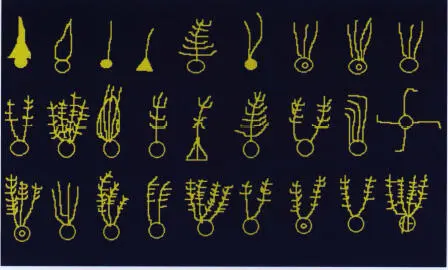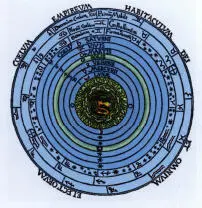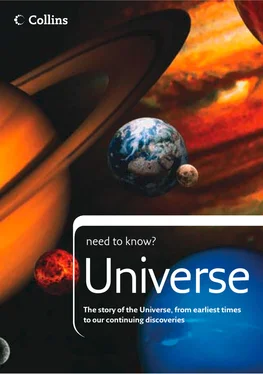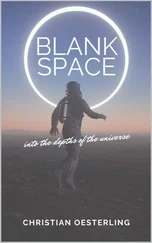Many examples of the ‘medicine wheel’ – a feature commonly constructed from stones laid on the ground which radiate from a raised central cairn to large circular stone rings – can be found across the United States and Canada. Smaller stone circles can often be found nearby these sites. Medicine wheels were constructed and used by native Americans from 4,000 years to a few hundred years ago. Astronomical alignments certainly exist in them, not only connected with the Sun and Moon but connected with the rising and setting points of numerous bright stars, which may have had special significance in native American religion and cosmology.
Ancient Stonehenge keeps a cold and silent vigil on England’s Salisbury Plain.
Far removed from the cradle of western civilisation, China developed its own form of astronomy, creating its own constellations and ideas about the workings of the Universe.
Over an almost continuous period spanning the 16th century BC to the end of the 19th century AD, court astronomers were appointed to observe and record changes in the heavens. This legacy of almost 3,500 years’ worth of astronomy, in which sunspots, aurorae, comets, lunar and solar eclipses and planetary conjunctions were noted, has provided us with a rich source of reference material.
Ancient Chinese astronomers created a catalogue of stars visible with the unaided eye, divided the skies into constellations known as ‘palaces’ and referred to the brightest star in each palace as its ‘emperor star’, surrounded by less brilliant ‘princes’. In the 4th century BC, the astronomer Shih-Shen catalogued 809 stars and recorded 122 individual constellations.
Instruments to aid naked eye observations were used extensively in ancient China, as they were in the west. In the 1st century, Lo-hsia-Hung constructed an armillary sphere – a device representing the celestial sphere, upon which were marked 365.25 divisions (for the days of the year), and rings for the celestial equator and the meridian. Lo-hsia-Hung’s charming analogy for the Universe likened the Earth to the yolk within an eggshell, stating ‘the Earth moves constantly but people do not know it; they are as persons in a closed boat; when it proceeds they do not perceive it’. In the 15th century an observatory was built on the southeastern corner of the city wall in ancient Beijing, which was equipped with a number of accurately calibrated sighting devices made out of bronze.
One of the most interesting records dates from 1054 AD and describes the sudden appearance of a ‘guest star’ near the star we know as Zeta Tauri. This bright star, initially brilliant enough to be seen during the daytime and visible to the unaided eye for more than a year, was caused by a supernova – the catastrophic explosion of a massive star. Its remnants are visible today as the Crab Nebula.
Astrology played an important role in ancient China. No fewer than 5,000 astrologers resided in 5th century Beijing! Twenty-eight constellations formed the ancient Chinese zodiac, through which the Sun, Moon and planets progressed. Each of the five planets was designated its own element – Mercury, water; Venus, metal; Mars, fire; Jupiter, wood; Saturn, earth. A person’s fate was supposedly determined by the relative position of the five planets, the Moon, Sun and any comets that happened to be in the sky at the time of that person’s birth.

Ancient Chinese astrological classification of comets – known as ‘broom stars’. Each shape was said to foretell a different event.
Many concepts about the Universe with which we are familiar today first arose in ancient Greece between 700 BC and 300 AD. Greek philosophers laid the foundations of modern astronomy.

Eudoxus envisaged the Earth at the centre of a series of crystal spheres upon which were fastened the Sun, Moon, individual planets and stars.
The Greeks benefited from the knowledge of the Universe that had been acquired by ancient Mesopotamian astronomers, and much of its ancient sky lore was also adopted and developed into fantastic celestial myths and legends. Quite unlike ancient Mesopotamia, conditions within the Greek civilisation allowed scientific enquiry to flourish. Ancient Greek philosophers were the first to determine the size of the Earth, the distance of the Moon and deduce the cause of solar and lunar eclipses. Greek philosophers enquired into the very nature of the cosmos, as attempts were made to explain objects and phenomena from the very small to the very big, from the basic atomic essence of matter to the structure of the Universe.
In the 4th century BC, in accordance with Pythagoras’ deduction that the circle and the sphere were perfect figures, Eudoxus devised a complete picture of the Universe, placing our planet at the centre of a nest of 27 concentric transparent celestial spheres to which were attached the Sun, Moon, planets and stars. Each of these Earth-centred spheres rotated around an axis shared with the Earth’s axis. Using 55 spheres, the system was ‘improved’ by Aristotle a century later. It was considered that the Sun, Moon and planets were perfect spherical objects, and circular motions were deemed to be the only paths that could possibly be followed by celestial objects. This notion held sway throughout the entire era of ancient Greek astronomy and persisted through to the renaissance.
In the 3rd century BC, Eratosthenes applied trigonometry to determine that the Earth is a sphere measuring around 40,000km in circumference, a remarkably accurate feat achieved by observing the length of the shadow cast by the Sun at noon from two widely separated places (Aswan and Alexandria) whose separation was known.
A contemporary of Eratosthenes, Aristarchus used geometry to calculate the sizes and distances of the Moon and the Sun. By observing the Moon’s half-phases and the angles made by the Earth, Sun and Moon, Aristarchus concluded that the Sun was 19 times further away than the Moon (the Sun’s actual distance is 400 times that of the Moon). He observed the Moon passing through the Earth’s shadow during lunar eclipses and concluded that the Moon was half the Earth’s size.
Hipparchus, working in the 2nd century BC, made accurate measurements of the orbit, distance and size of the Moon, and determined the distance of the Sun. Using an accurately constructed naked eye measuring device called an astrolabe, he observed and recorded the co-ordinates of around 850 stars to compile a star catalogue. Another major star catalogue was compiled in the 2nd century AD by Ptolemy, who included it in an encyclopedia of ancient Babylonian and Greek knowledge.
must know
Very little is known of Ptolemy’s life. He made astronomical observations from Alexandria in Egypt during the years 127–41 AD. The first of Ptolemy’s observations can be dated to 26 March 127, while his last known observation was made on 2 February 141.
Ptolemy’s Earth-centred view of the Universe held sway in the west for around 1,500 years. Credit for the idea that the Sun, not the Earth, lies at the centre of the Solar System is often given to Nicolaus Copernicus (1473–1543).
Читать дальше














